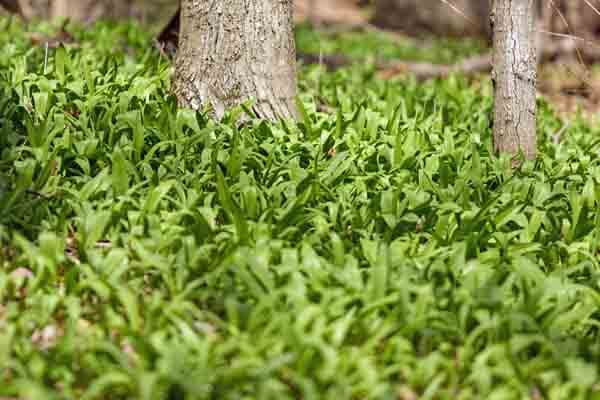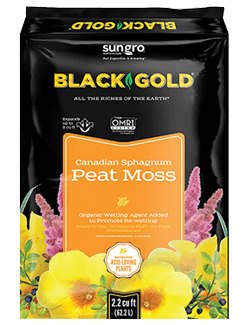
Ramps (Allium tricoccum), also called spring onions, are native woodland onions that have gained popularity among chefs and gardeners. The closely related ramsons (Allium ursinum) grow similarly, but they are Eurasian and have different floral characteristics. Both wild onions are grown for their greens and bulbs that taste of garlic and onion, and each makes a fitting addition to spring woodland or edible gardens.
Ramps

Ramps are true forest spring ephemerals—meaning they appear in early spring, before the forest trees leaf out, and disappear by summer by the time the trees provide full shade. They are native to northeastern North America, from Georgia to the far reaches of Quebec, so they are remarkably hardy and well-adapted to eastern and northern landscapes and gardens.
Ramps have a long history of culinary use. Native American tribespeople of the northeast harvested them for traditional dishes, and early colonists also learned to eat the wild roots in place of cultivated onions. These days ramps have gained new popularity in culinary circles, a trend spurred on by contemporary wild food enthusiasts.
The broad, aromatic leaves of ramps first appear in early spring. Once they have reached their full height of 6 to 10 inches, they can be harvested. The leek-like onions have white bulbs with purple sheaths. By May or June, the leaves begin to die back, at which point delicate greenish-brown flower stalks appear. These give rise to clusters of ivory flowers, followed by papery heads filled with black seeds. Ramps naturalize by seed and bulb, so be sure to leave some to spread for next year’s harvest.
Ramsons

The closely related ramsons (also called wild bear leek) are similar to ramps, but they originate from northern Eurasia. They have been eaten by peoples of the region since Mesolithic times, and they are an important food for wild animals, such as boar and bear.
Unlike ramps, the showy clusters of white flowers bloom when the plants are in full foliage, making ramsons even better candidates for ornamental woodland gardens. The plants are more variable in height, reaching between 4 to 18 inches, and their large clusters of white, starry flowers are very showy. Foliage first appears in early- to mid-spring and flowers reach full bloom by late spring.
Ramsons are very popular in Europe, but more of a rarity in the US. This is a shame because they are so attractive and delicious. All parts may be eaten, from the flowers to the bulbs. The plants naturally spread by seed, so be sure to leave seed heads, if you want seedlings.
Growing Ramps and Ramsons

Imagine the leafy floor of an eastern hardwood forest; this is the best growing environment for ramps. They like soil that’s moist and rich in organic matter and will naturally proliferate beneath deciduous trees. This does not mean they are shade-loving. The plants leaf out and gather sunlight before the trees have fully leafed out, so they are truly sun-loving. This means they can be planted in any sunny garden setting with fertile soil.
 If you don’t have a wooded landscape, choose any raised garden with quality soil. Studies have shown that ramps grow best in acid soils with an average pH of 5.5, so be sure to amend alkaline soils with an acidifying soil conditioner. Amending soils with OMRI Listed Black Gold Peat Moss will help acidify soils while adding needed organic matter. Ramps have also been shown to prefer soils rich in calcium and magnesium, so also consider adding a fertilizer high in these nutrients.
If you don’t have a wooded landscape, choose any raised garden with quality soil. Studies have shown that ramps grow best in acid soils with an average pH of 5.5, so be sure to amend alkaline soils with an acidifying soil conditioner. Amending soils with OMRI Listed Black Gold Peat Moss will help acidify soils while adding needed organic matter. Ramps have also been shown to prefer soils rich in calcium and magnesium, so also consider adding a fertilizer high in these nutrients.
If started from seed, ramps and ramsons will take two to three years before they reach harvestable size. Moreover, the seeds can be difficult to start, so it’s better to plant bulbs. Specialty nurseries, like The Ramp Farm, sell bulbs in bulk. (Ramson bulbs are more difficult to buy in the US, but American Meadows does sell seed.) Bulbs planted in fall should be ready to harvest within a year.
Unless you own your own wooded property with native ramps, refrain from collecting them in the wild. Ramp fervor puts wild populations under threat, and they are so easy to grow, there’s no need to take them from nature.
Enjoying Ramps and Ramsons

Ramps taste great in any recipe that highlights leeks or onions. One note about eating ramps: Like other onions, they contain sulfides, which can cause stomach trouble if consumed in large quantities. So, specialists recommend ramps be eaten in low to moderate quantities. According to Cooking for Geeks: Real Science, Great Hacks, and Good Food by Jeff Potter, cutting and soaking onions, such as ramps, can reduce the number of water-soluble sulfides in the vegetables.
Ramps are prolific across the Appalachians, so the region is home to many ramps festivals. One of the most popular is the North Carolina Ramp Festival, first started in the early 1930s and celebrated each May in Waynesville, NC. The event includes lots of ramp delicacies along with live music and dancing.
Ramps are popular, yet underplanted, so be the first in your garden circle to grow them. You can surprise your friends with fresh cream or ramp soup, or show off the pretty plants in your woodland or herb garden.
